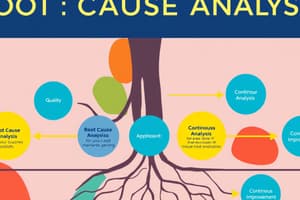Podcast
Questions and Answers
Match each root cause analysis tool to its major strength.
Match each root cause analysis tool to its major strength.
Best for sorting important causes from less important causes = Pareto Analysis Good for complex problems = Fishbone Diagram Excellent for simple, straightforward problems = The Five Whys bonus = bonus
What needs to be included in an effective problem statement?
Instruction: Choose all options that best answer the question.
What needs to be included in an effective problem statement?
Instruction: Choose all options that best answer the question.
- Options for possible solutions (correct)
- One ideal solution written out in detail
- A sentence or two defining the problem (correct)
- Deep details of all possible underlying causes
What is the proper order of the steps in the process of conducting a root cause analysis?
Instruction: Match each step to its correct sequence in the process
What is the proper order of the steps in the process of conducting a root cause analysis?
Instruction: Match each step to its correct sequence in the process
Employing an appropriate tool or technique for capturing root causes = 3 Recognising problems as opportunities for growth and innovation = 1 Analysing the environments in which the problem occurs, both internal and external = 2 Gathering insights and investigating further if warranted = 4
Problem Solving: Defining and Stating the Problem
Background: A company that manufactures computer chips has noticed an increase in complaints about chip failure from the electronics companies that use these chips.
Question: What information does the company need to define the scope of this identified problem?
Instruction: Choose all options that best answer the question.
Problem Solving: Defining and Stating the Problem
Background: A company that manufactures computer chips has noticed an increase in complaints about chip failure from the electronics companies that use these chips.
Question: What information does the company need to define the scope of this identified problem?
Instruction: Choose all options that best answer the question.
Flashcards are hidden until you start studying
Study Notes
Root Cause Analysis Tools and Strengths
- Fishbone diagram: Excels in visualizing root causes and categorizing them
- 5 Whys: Effective for drilling down to the core issue through iterative questioning
- Pareto analysis: Highlights the most significant issues by identifying key contributors
Effective Problem Statement Components
- Clear articulation of the current issue
- Specificity regarding the scope and impact of the problem
- Inclusion of measurable indicators to assess the problem's severity
- Definition of affected stakeholders and processes
Steps in the Root Cause Analysis Process
- Identify the problem: Clearly state the issue being addressed
- Collect data: Gather relevant information and evidence related to the problem
- Identify possible causes: Brainstorm and list potential root causes
- Analyze causes: Investigate and validate the potential causes through analysis
- Implement solutions: Develop and put in place actions to address the root causes
- Monitor effectiveness: Measure the outcomes of the implemented solutions to ensure resolution
Defining the Scope of the Problem
- Data on the frequency of chip failures and complaints from clients
- Analysis of production processes to identify potential failures
- Feedback from electronics companies regarding the nature of the chip failures
- Overview of customer impact, including financial implications and reputational damage
Studying That Suits You
Use AI to generate personalized quizzes and flashcards to suit your learning preferences.



